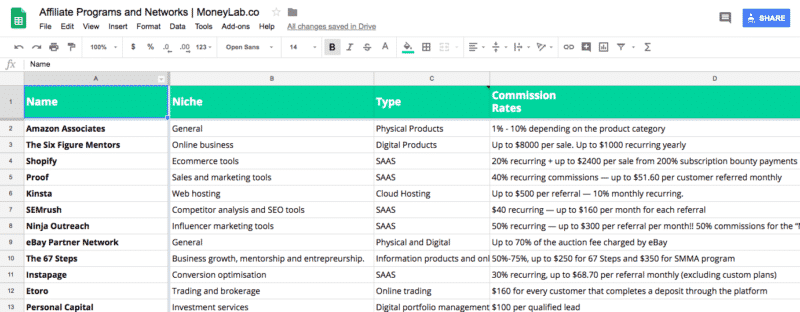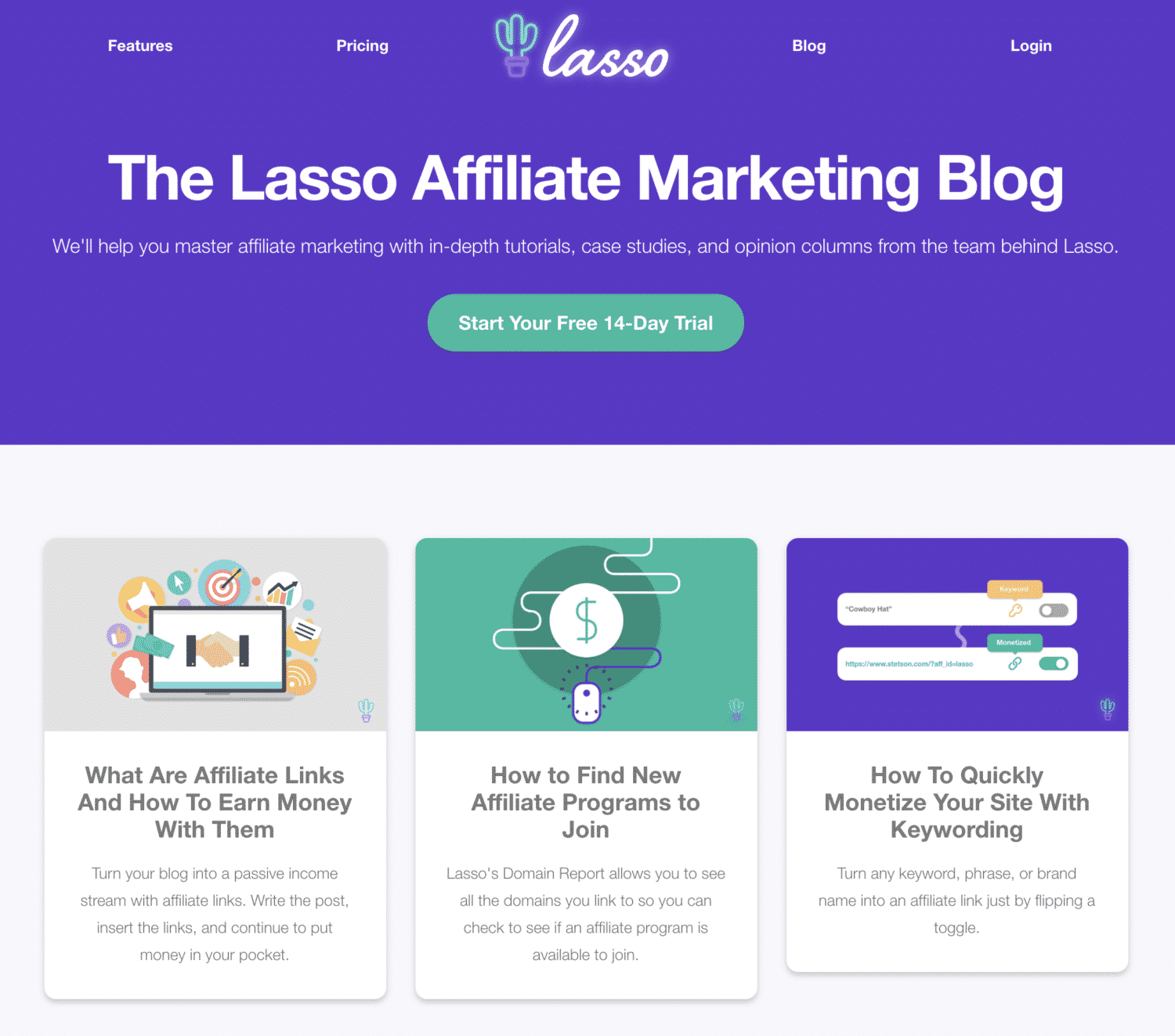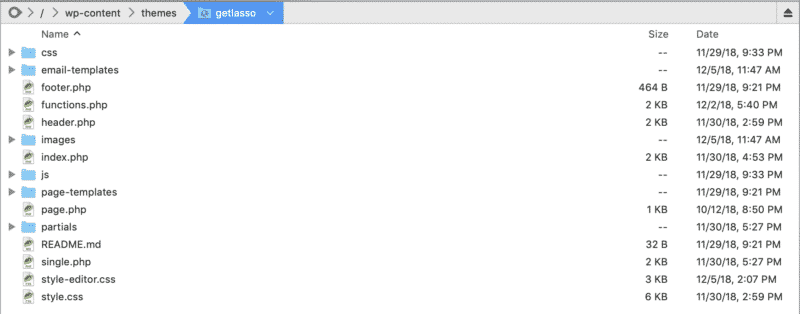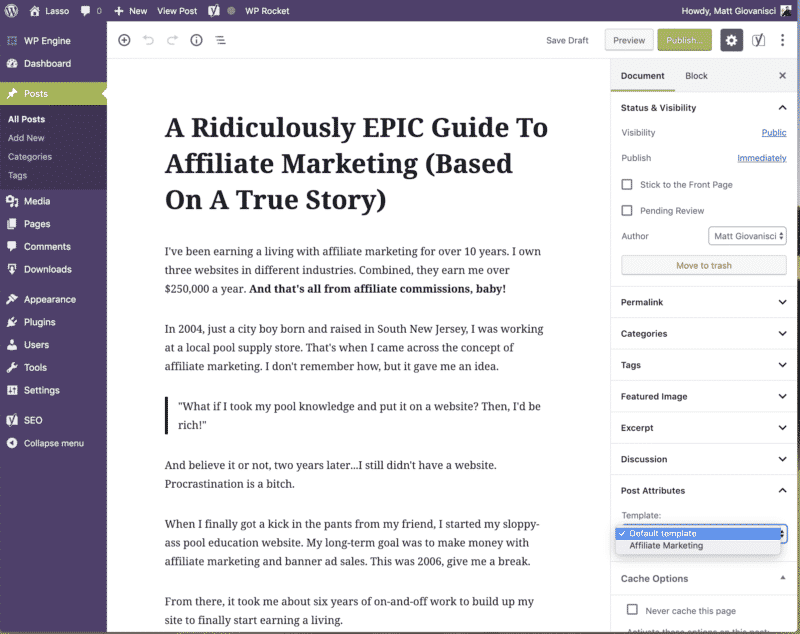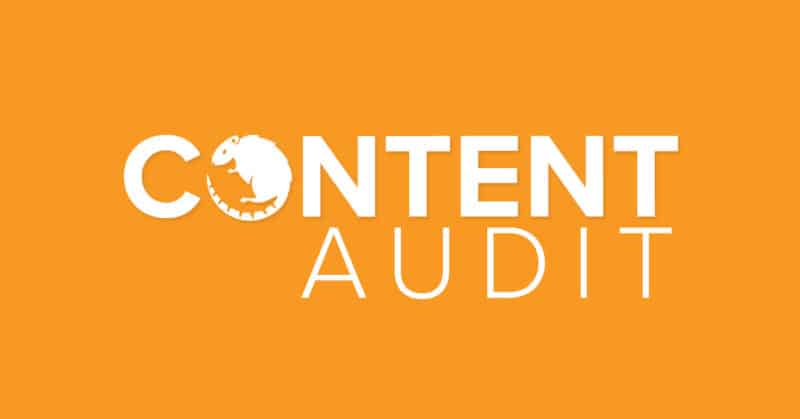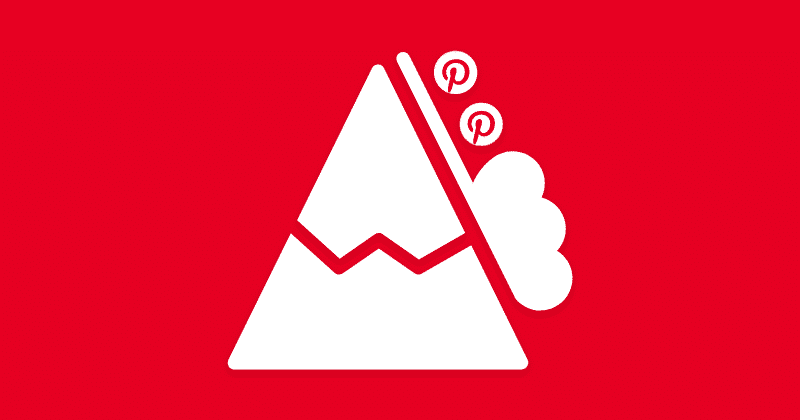My rule for conducting a Money Lab challenge is it must have a tight deadline with the goal of making money. Experiments, on the other hand, can be ongoing and don’t have to make money directly.
The Hypothesis
This experiment is to prove I can rank on the first page of Google for a highly competitive keyword simply by creating the best page on that topic.
That keyword is “affiliate marketing.”
I’m trying to rank for this keyword to promote Lasso: an affiliate link manager for WordPress.
According to Ahrefs.com, “affiliate marketing” has a keyword difficulty score of 71 out of 100, which means it’s VERY competitive. A lot of pages rank for it (2.5 million) and sees about 76,000 searches a month.
What I’m Starting With
I’ve studied and practiced SEO since 2004. I own two websites that rank for highly competitive keywords and created an SEO video course for bloggers. And I also know how to make a website lightning fast, which is now extremely crucial for SEO (according to Google).
I can design and code a web page from scratch. And I’ll be doing all the research and writing too.
I’m publishing the post on the Lasso blog. It’s hosted on WPEngine. This comes with some built-in SEO benefits:
- A free SSL Certificate. Google has made it clear that they reward sites that are protected by an SSL cert. All that means is you use HTTPS instead of just HTTP.
- The WPEngine servers are super fast! And speed is VERY important for SEO. Not just for Google, but for users on mobile devices.
- A motherfucking CDN. It stands for “content delivery network,” and it makes your pages fast as balls by displaying your images from a different server! But I’ll be using Cloudflare.
- Built-in SEO power from WordPress. The guts of WordPress are SEO-friendly. And I use a popular plugin called Yoast SEO, which handles all the extra SEO goodies.
This is a fairly new domain (getlasso.co) so this could be a difficult challenge if you believe that backlinks are still key to good SEO.
Which I don’t.
How I Plan To Prove That “Epic” Content Actually Works
The online entrepreneur and blogging community talk about creating “epic” content. But what the fuck does that really mean? 12,000-word articles, well-designed infographics, viral videos?
I don’t think so.
I believe it’s creating a one-stop-shop for solving a particular problem. In this case, that problem is affiliate marketing, which can already be solved by Googling to find the right articles in the right order.
But what if one web page had all the information you need in an easy-to-read format with lots of visual aid and downloadables? And what if it didn’t have to be LOOOOOOOOOOOONG as shit?
I’m assuming that creating this type of web page will:
- Allow me to share it on popular Facebook groups and not get banned because of self-promotion. If the content is over-the-top excellent, it wouldn’t be considered self-promotion, right? It would instead be a great resource to help the community. This happened with my Podcast Marketing article. Not only did I share it and not get banned, but other people shared it again in the same group. And they continue to share it to this day. Years after I wrote it.
- Help build lots of backlinks naturally. When you make something incredible, people share it and link to it on their own websites. This means I don’t have to do any manual link building to rank. Again, if you even believe this matters anymore. Which again, I don’t.
- Get readers to bookmark it and refer to it often. I’m not sure if this helps SEO, but it helps real humans.
- Reduce “pogo-sticking.” In the SEO world, the act of pogo-sticking refers to clicking back and forth between results to find what you need. Apparently, Google penalizes sites that this happens to a lot. Meaning, people click on it and hit the back button quickly when they realize it’s not what they’re looking for.
- Go viral when I first share it. When you create something so good and outside the box, the community will share it like crazy. And since the topic is something tight-knit internet people will love, that sharing happens more often.
And because of all these benefits, I’m hoping Google rewards us for the effort of creating the best content on the web for affiliate marketing.
NOTE: I understand that SEO is a fluffy subject. I never speculate or assume what goes on behind closed doors at Google. So again, this is all speculative and based on my own theories and experiments. My assumption is that you can rank any web page, regardless of authority, with great writing, design, and ridiculous amounts of creative drive.
The SEO Impossible Plan
1. Collect An Insane Amount of Data
To create a one-stop-shop about affiliate marketing, I have to cover all the subtopics. This means collecting a ton of data to make sure I cover everything.
My research tactic is simple: Google “affiliate marketing,” open up every link in the search results in different tabs, and start taking notes in a Google Doc.
I won’t be actually reading any of these posts. Instead, I’ll be skimming for topics I need to cover in the post. And specific words I need to use. I’m using my best judgment here.
2. Create a Massive Outline
Once I have all the research completed (or during my research), I will create an outline in a Google Doc.
This will be a long process, but the most important if I plan to make the best web page on the internet for affiliate marketing.
3. Write As Much As I Possibly Can
Once I have my outline and subtopics, I’ll add them all as tasks in Asana and assign them to myself one by one.
Writing is my greatest weakness, so this will be the hardest part of the challenge for me.
4. Edit Like Crazy
Editing will be non-stop. Even after it’s been published, I plan to continue editing the words and updating the page as the industry changes.
This will make the content “evergreen” – a dumb internet marketing term for information that stands the test of time.
5. Start Designing
I’ll be working on the design and user experience of the page while researching and writing.
One of the bigger challenges will be the user experience. Since I’m dealing with a large amount of content on a single page, I may have to add some fancy javascript to make it easier to consume.
We’ll see. I would like to avoid that.
6. Share and Promote Like Crazy In a Single Day
My theory is that it’ll only need a jumpstart. I won’t need to tweet it multiple times a day or add it to an autoresponder. I can just spend ONE day promoting it and let it take off from there.
Here are some things I can do:
- Send it to the MoneyLab.co email list: about 1,800 people (as of June 2020).
- Share it with Facebook groups about internet marketing. Personally, I’m part of about 10.
- Share it ONCE on other social networks like LinkedIn, Twitter, Pinterest, etc.
- Personally send it to a couple of high-profile entrepreneurs who might appreciate it.
- This article might help it, too.
Hopefully, it’ll take on a life of its own quickly. Then it’s a matter of waiting and sharing the results as it climbs the Google SERPS.
Traditional SEO Tactics I’ll Be Using
SEO might be a mystery to you; it should be. It’s even a mystery to people who study it.
These are tactics I’ve used for over 10 years. They don’t go out of style, and most importantly, they help the reader.
- Title and Description – I spend a lot of time crafting the headline/title. First, I come up with a title that feels natural. Then, some research to make sure I’m using the right keywords.
- Headings – The title of the page will be the only H1 tag. Then, each section of the web page should have it’s own H2 headline (which we can use the Headline Analyzer tool for) and H3 tags to further breakdown content.
- Responsive Design – Google has made it clear in the past that they reward sites that work well on mobile. So it’s important that it’s responsive.
- Speed – Google has also made it clear that they reward fast websites. This makes what we’re doing a bit challenging because the page will be massive in content.
- Off-Page SEO – I’m not building backlinks. I’m focused on the content itself and how the page is designed. The only off-page SEO plan is to do a single day of promoting and sharing. I’m hoping that this little jump start is all it’ll need.
Step One: Researching & Outlining
All I did was search the term “affiliate marketing” in Google and opened up the top 20 results in different windows.
I scanned each page, looking for headings and topics to add to my post. I collected a lot of that information into a single Google Doc. Then, I transferred all the good information into an Asana project with the copied text.
Here’s my outline in Asana:
The research and outline phase only took me a few hours. Most of what I found was all the same information. It’ll be challenging to come up with some new angles to write about. Challenge accepted!
I’ve assigned myself parts of the outline to start writing.
Step Two: Writing
I’ve been procrastinating on this. As much as I write on Money Lab, I still don’t like it.
I started writing one day as if I was teaching the subject of affiliate marketing to my readers. But I felt icky and gave up.
It took me a while to get back into finishing this experiment. I knew I had to come up with a different style for creating this post, especially since it’s going to live on Money Lab.
Day One: Focus
I shut down my email, Slack, and Twitter windows to focus. I opted to work on the couch with my laptop. I feel like this forces me to write since I don’t have a mouse.
The goal was to just write my face off. And I can only write what I know. I’m not writing a research paper; I’m writing about my experience with affiliate marketing over the last 10 years. All while sprinkling in the facts I’ve researched.
I found this style of writing to be much easier. Plus, it fits with the writing style of Money Lab. My goal is to teach by example. I tell you exactly what I did, what worked, and what didn’t. I don’t teach AT you.
With that said, I wrote 2,230 words in two hours. I edit while I write too. Also, I’m taking screenshots, doing research, and improving things as I go.
My goal is to get at least past 5,000 words by the end of the week if not sooner. Once, I’ve gotten the words down, I’ll spend another week editing and improving the flow/design.
Day Seven: Wrapping Up
I finished writing the entire post. I ended up with 7,851 words. It’s a sloppy 7,851 words right now, but I’m taking a break to work on the other parts of the project.
My hope is that this break will detach me from the writing enough that when I go in for all the editing rounds, I’ll have fresh eyes.
Usually, when I take a long break between writing and editing, I edit a lot more aggressively. And I’ll find new stuff to write about.
So all in all, this took me seven days of on-and-off writing to finish. A lot of that time was spent coming up with new ideas and researching more ways I can improve on the project.
Adding Mini Side-Projects
I’m digressing a bit here. As I was writing, I came up with all sorts of ideas. And I’m acting on all of them.
But one thing struck me as I was researching content I wanted to link to in the post. I sent out a survey asking people to provide the best post they know of about content promotion. And a few good ones came through.
One, in particular, was 12,000 words. And while I was reading it, I had this sense of underwhelming. It was not an epic post, it was just long. And it was boring.
I want to avoid this. Just because something is lengthy, doesn’t mean it’s good. Anyone can write a book, but a good book is hard. What I’m trying to do is write a great page that gets shared so it ranks. Even if it has fewer words on the page than what Google is currently ranking.
So with that said, I decided to add a bunch of extra content to the post that isn’t in the form of words. Here’s what I mean.
1. A Live, Updated Spreadsheet of Every Affiliate Program In The World
There is a fuck-ton of affiliate programs you could sign up for. But it can be hard to find. So I hired a VA to help me put together a Google Sheet of every damn affiliate program we can find. And I’m going to offer a link to this sheet in the article for free.
Here’s what it looks like so far:
2. A Massive Easter Egg
The post takes a lot of my personal stories of what NOT to do when starting an affiliate marketing site. And one of those stories from my past I decided to recreate as a joke.
I don’t want to spoil the surprise. But I’m planning to hide a big easter egg (probably a few) on the page. This is to reward people to actually read it.
I want to put a lot of effort into this project to make it truly EPIC and worth anyone’s time.
Setting Up The Whole Website
Since I’ll be publishing this affiliate marketing page on GetLasso.co, the first thing I have to do is actually build GetLasso.co.
I’m keeping things really simple for the full site. It’ll use a lot of the same code I created for my other sites. The goal is clean, simple, and fast.
Once the site is complete, I’m going to create custom POST templates. Meaning, I can create custom HTML on a specific Post in WordPress. This will allow me to make that one post look completely different than the rest of the blog posts that will eventually fill the site.
Here’s the homepage of where all the blog posts will live.
Now I have to set up the custom post templates. I created a folder in my theme called “page-templates.” Apparently, I have to name it that or else it won’t work.
Then, I created a template file called “affiliate-marketing.php.” I must add some PHP code at the top of the page for it to appear as a selectable template in posts.
Sweet! Now I can go into the post-draft and select that template I just created. I’ll use this blank HTML template to craft the entire website with words, images, videos, etc. I do this a lot on Money Lab, so most of this affiliate marketing website will be created in pure HTML/CSS from scratch (using the bootstrap grid).
Ok, now it’s time to start taking the words I wrote and designing it into a full-blown interactive and amazing custom web page. Let the time-consuming work begin!


